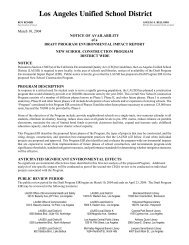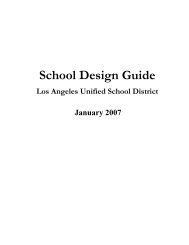Site-Specific Health and Safety Plan (HASP) - Laschools.org
Site-Specific Health and Safety Plan (HASP) - Laschools.org
Site-Specific Health and Safety Plan (HASP) - Laschools.org
Create successful ePaper yourself
Turn your PDF publications into a flip-book with our unique Google optimized e-Paper software.
LAUSD Proposed South Region High School #9 & Middle School #4<br />
12-2<br />
December 2006<br />
<strong>Site</strong> <strong>Specific</strong> <strong>Health</strong> & <strong>Safety</strong> <strong>Plan</strong> (<strong>HASP</strong>)<br />
contamination reduction zone, <strong>and</strong> the control of decontamination operations, are described in<br />
Section 13.<br />
12.1.3 Support Zone<br />
The support zone is the outermost area of the site <strong>and</strong> is considered a non-contaminated or clean<br />
area. The support zone contains the comm<strong>and</strong> post for field operations, first-aid stations, <strong>and</strong><br />
other investigation <strong>and</strong> cleanup support. Normal work clothes are appropriate apparel within this<br />
zone. Potentially contaminated personnel, clothing or equipment are not permitted.<br />
12.2 SITE SECURITY<br />
<strong>Site</strong> security for investigation <strong>and</strong> remedial activities is necessary to prevent exposure of<br />
unauthorized, unprotected individuals in the work area. No unauthorized personnel shall be<br />
allowed within the fenced perimeter of the <strong>Site</strong>. <strong>Site</strong> access will be coordinated with the LAUSD<br />
security at the <strong>Site</strong>. <strong>Site</strong> security for specific tasks will be enforced by the SHSO or a designated<br />
alternate who will ensure that only authorized personnel are allowed in the work area <strong>and</strong> that<br />
entry personnel have the required level of PPE, are trained under the requirements of Title 8<br />
CCR 5192, <strong>and</strong> are on a current medical monitoring program.<br />
General site security also is necessary to protect site workers <strong>and</strong> LAUSD property from<br />
individuals who approach the site with intent to cause harm or damage. In the event that<br />
individuals approach the site with intent to cause harm or damage, h<strong>and</strong>held radios will be used<br />
to communicate the potential danger between the LAUSD security comm<strong>and</strong> post at the site <strong>and</strong><br />
on-site workers. The LAUSD security personnel will contact the local police department, if<br />
necessary. On-site workers will take refuge in their work vehicle.<br />
12.3 SITE COMMUNICATION<br />
Internal site communication is necessary to alert field team members in the exclusion <strong>and</strong><br />
contamination reduction zones to:<br />
• Emergency conditions;<br />
• Convey safety information; <strong>and</strong><br />
• Communicate changes or clarification in the work to be performed.<br />
For internal site communication, the field team members will use prearranged h<strong>and</strong> signals (<strong>and</strong><br />
responses). Radios may also be used for communication in the event of an emergency to alert<br />
employees.<br />
<strong>Site</strong> alarms include:<br />
One horn blast = look this way; pay attention<br />
Three horn blasts, repeated = local evacuation, gather at field office for further instructions<br />
Five horn blasts, repeated = general site evacuation, gather off-site (north of site on Adella)<br />
External site communication is necessary to coordinate emergency response teams <strong>and</strong> to<br />
maintain contact with essential offsite personnel. A telephone located at the LAUSD security<br />
guard station will be available for use for external site communication. In the event that the l<strong>and</strong><br />
238







